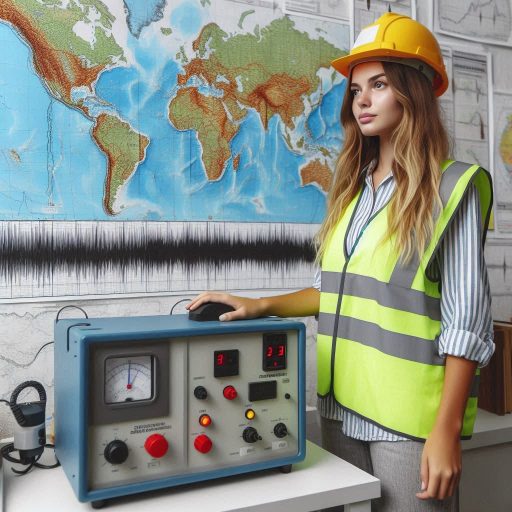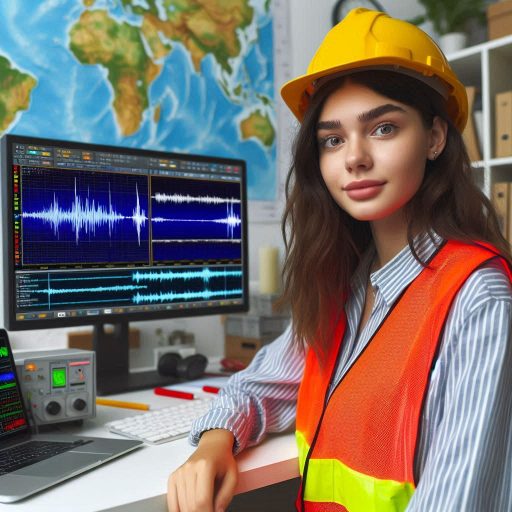Introduction
Seismology is the scientific study of earthquakes and seismic waves.
This field is critical for understanding the Earth’s structure and predicting natural disasters.
By studying seismic activity, scientists gain insight into the dynamic processes beneath our feet.
Famous seismologists, like Charles Richter and Inge Lehmann, significantly contributed to our knowledge.
Charles Richter developed the Richter scale, which measures earthquake magnitude.
This scale revolutionized how we quantify the strength of earthquakes.
Understanding the magnitude helps authorities assess the potential impact on communities.
Inge Lehmann made groundbreaking discoveries about the Earth’s inner core.
She identified the solid inner core, which lies beneath the outer core.
Her work expanded our understanding of the Earth’s structure and composition.
Lehmann’s contributions have influenced subsequent research in geophysics and tectonics.
The contributions of famous seismologists have been instrumental.
They have enhanced our understanding of the Earth’s geology and its inner workings.
Their pioneering work not only advances scientific knowledge but also protects lives and infrastructure.
By continuing to study seismic waves, we can further improve disaster preparedness and response efforts.
Seismology remains a vital field for safeguarding our planet against natural disasters.
Early Pioneers in Seismology
Seismology is the study of earthquakes and the seismic waves they produce.
Early pioneers in this field made significant contributions that shaped modern seismology.
Two of the most influential figures were John Milne and Charles Francis Richter.
John Milne
John Milne (1850‘1913) played a vital role in establishing seismology as a scientific discipline.
His work laid the groundwork for future researchers. Key contributions include:
- Development of the First Seismometer: Milne created the horizontal pendulum seismometer.
This device significantly improved earthquake detection and measurement. - Founding of the Seismological Society of Japan: Milne founded this society in 1880.
It promoted research and collaboration in seismology. - Seismic Studies: Milne conducted extensive seismic studies in Japan.
He collected data on numerous earthquakes, enhancing the understanding of seismic waves.
Milne‘s findings revolutionized how scientists approached earthquake research.
His work encouraged a systematic study of seismic activity.
Their contributions to the field of seismology
Charles Francis Richter (1900‘1985) is best known for creating the Richter scale.
This logarithmic scale measures the magnitude of earthquakes.
His contributions transformed how people perceive seismic events.
Significant achievements include:
- Introduction of the Richter Scale in 1935: Richter developed this scale to provide a standardized method for measuring earthquake magnitudes.
It allowed for consistent comparisons of seismic events. - Improved Earthquake Measurement Techniques: Richter refined methods for determining the magnitude of earthquakes.
His techniques included using seismographs to measure seismic waves. - Influential Research Papers: Richter published numerous papers on seismology.
His work educated scientists and the public about earthquakes and their effects.
Richter’s scale remains a critical tool in seismology today.
It enables scientists to communicate the severity of earthquakes effectively.
Laying the Foundation for Modern Seismology
The work of Milne and Richter laid a robust foundation for modern seismology.
Their contributions established essential principles and methodologies that continue to be relevant.
Key impacts include:
- Standardization of Seismic Measurements: Milne and Richter’s innovations standardized how scientists measure and report earthquakes.
This consistency aids in global data sharing. - Advancement of Seismic Research: Their findings encouraged further research in seismology.
They inspired generations of scientists to explore and understand seismic phenomena. - Public Awareness of Earthquake Risks: Milne and Richter raised awareness about the dangers of earthquakes.
Their work prompted advancements in earthquake preparedness and safety.
John Milne and Charles Francis Richter significantly impacted seismology.
Their pioneering efforts shaped the field and continue to influence earthquake research today.
Their legacies remain essential as we strive to understand and mitigate the effects of seismic activity.
Read: Challenges and Rewards: The Dual Life of an U.S. Environmental Scientist
Modern Seismologists and Their Research
Seismology has evolved significantly over the years.
Modern seismologists have made groundbreaking contributions to our understanding of earthquakes and seismic waves.
Notable figures in this field include Hiroo Kanamori and Susan Hough.
Hiroo Kanamori
Hiroo Kanamori is a prominent seismologist known for his extensive research on seismic waves.
He developed the moment magnitude scale (Mw), which measures earthquake size.
This scale has replaced the older Richter scale and offers a more accurate representation of earthquake magnitude.
Kanamori’s work allows researchers to assess the energy released during earthquakes effectively.
His research on plate tectonics has also shaped our understanding of seismic activity.
Kanamori identified the relationship between tectonic plate movements and earthquake generation.
His insights have paved the way for better earthquake prediction and risk assessment.
By analyzing seismic wave data, he has provided critical information about the Earth’s interior structure.
Susan Hough
Susan Hough is another influential seismologist who has significantly contributed to earthquake research.
She specializes in the study of seismic hazards and risk communication.
Hough has authored several books on earthquakes, making complex concepts accessible to the public.
One of her notable contributions involves understanding the 1906 San Francisco earthquake.
Hough’s research analyzed historical records and seismic data to reconstruct this event.
Her work has enhanced our knowledge of earthquake frequency and recurrence intervals.
She emphasizes the importance of educating communities about seismic risks.
Groundbreaking Research
Both Kanamori and Hough have made substantial advancements in seismology through their research:
- Moment Magnitude Scale: Kanamori developed this scale, improving earthquake measurement accuracy.
- Plate Tectonics: His research elucidates the connection between plate movements and earthquakes.
- Seismic Hazard Assessment: Hough’s work focuses on evaluating potential risks from earthquakes.
- Public Education: Hough actively promotes earthquake preparedness and risk communication.
These contributions have transformed how scientists study and understand seismic activity.
Their research has significantly advanced the field of seismology, enabling better prediction models and risk management strategies.
Advancing Our Understanding
The work of modern seismologists like Kanamori and Hough has profound implications.
Their findings inform building codes and disaster preparedness plans.
Improved understanding of seismic activity helps communities minimize damage during earthquakes.
As we face increasing seismic risks, the contributions of these seismologists become more critical.
Their research enhances public safety and fosters resilience in earthquake-prone regions.
Continued efforts in seismology will undoubtedly lead to further advancements, improving our ability to understand and respond to seismic events.
Modern seismologists play a vital role in advancing our knowledge of earthquakes.
Through their groundbreaking research, they enhance our understanding of seismic activity and contribute to public safety.
Read: Job Market Trends: Future of Chemistry Jobs in America
Contributions to earthquake prediction
Explore the Work of Thomas C. Hanks and Lucile M. Jones
Thomas C. Hanks and Lucile M. Jones are renowned figures in the field of seismology, recognized for their groundbreaking work in earthquake forecasting.
Their combined expertise drives advancements in predicting earthquakes.
They dedicate themselves to understanding seismic phenomena.
This work helps mitigate earthquake impacts significantly.
Hanks, an accomplished seismologist, has contributed extensively to the development of statistical models that analyze seismic data.
Jones, a respected researcher and former director of the United States Geological Survey (USGS) Southern California Seismic Network, prioritizes public outreach.
He educates communities about earthquake risks.
Together, their collaborative efforts have transformed earthquake forecasting into a more reliable and scientifically grounded discipline.
Discuss Their Efforts in Developing Earthquake Forecasting Models
Hanks and Jones focused on developing sophisticated earthquake forecasting models that integrate both historical seismic data and advanced statistical techniques.
They introduced probabilistic seismic hazard assessments.
These assessments quantify the likelihood of earthquakes in specific areas over defined periods.
This approach provides a nuanced understanding of seismic risk.
It helps scientists and policymakers make informed decisions about urban planning and infrastructure development.
Their research emphasizes the significance of long-term seismic monitoring and the need for continuous data collection.
By analyzing patterns of past earthquakes, they have identified potential precursors and common characteristics that can indicate future seismic activity.
Researchers emphasize the need to understand complex interactions between different fault systems.
These interactions can trigger larger, more destructive earthquakes.
Hanks and Jones advocate for the integration of real-time data into forecasting models, making them more responsive to changing seismic conditions.
Highlight the Impact of Their Research on Public Safety and Disaster Preparedness
The impact of Hanks and Jones’s research on public safety and disaster preparedness cannot be overstated.
Their models provide invaluable insights that inform local governments, emergency management agencies, and the general public about earthquake risks.
By translating complex seismic data into actionable information, they empower communities to take proactive measures to reduce vulnerability.
For example, their research has been instrumental in developing early warning systems that alert residents before the shaking from an earthquake reaches their location.
These systems can provide critical seconds of warning, allowing people to drop, cover, and hold on‘actions that can significantly reduce injuries during an earthquake.
Moreover, their findings have led to improved building codes and land-use policies aimed at minimizing structural damage in earthquake-prone areas.
In addition to enhancing technical responses, Hanks and Jones have prioritized public education.
They conduct outreach programs that educate communities about earthquake preparedness.
They promote practices like emergency kits, family communication plans, and community drills.
Their efforts have created a culture of preparedness.
Residents know the risks and can respond effectively during a seismic event.
Read: Challenges and Rewards: Navigating the Chemist Career Path
Transform Your Career Today
Unlock a personalized career strategy that drives real results. Get tailored advice and a roadmap designed just for you.
Start Now
Innovations in Seismic Technology
Seismology has advanced significantly due to the contributions of notable seismologists.
Their innovations have transformed how we monitor and understand seismic activity.
This section examines the contributions of John Filson and Clarence Allen.
Their pioneering work has greatly enhanced seismic technology.
John Filson’s Contributions
John Filson played a crucial role in advancing seismic instrumentation.
He developed the digital seismograph in the 1970s.
This technology allowed for more precise measurements of ground motion.
Filson‘s innovations included:
- Improved data accuracy: Digital seismographs increased the accuracy of seismic readings.
- Enhanced recording capabilities: His devices could capture more data over longer periods.
- Real-time monitoring: Filson‘s technology enabled researchers to monitor seismic events as they occurred.
Filson’s work laid the foundation for modern seismology.
His innovations allowed for more detailed analyses of earthquakes.
Seismologists could now study seismic waves in real time, leading to better understanding and predictions.
Technologies for Monitoring Seismic Activity
Clarence Allen also made significant contributions to seismic technology.
He focused on developing the seismic network system in the 1960s.
His innovations in network design improved earthquake detection and response.
Key aspects of Allen’s work include:
- Expansion of seismic networks: He expanded the number of seismic stations, enhancing data collection.
- Integration of technology: Allen integrated various instruments into cohesive monitoring systems.
- Data sharing protocols: He established protocols for sharing seismic data among researchers and institutions.
Allen‘s efforts revolutionized how seismologists gathered and analyzed data.
His network systems improved the ability to detect and locate earthquakes quickly.
This advancement significantly enhanced the global understanding of seismic activity.
Innovations have Revolutionized the Field of Seismology
The contributions of John Filson and Clarence Allen have revolutionized seismology.
Their innovations improved the accuracy and efficiency of seismic monitoring.
As a result, scientists can now predict earthquakes with greater precision.
These advancements have also enabled more effective disaster preparedness.
Key impacts include:
- Enhanced early warning systems: Improved technology allows for quicker alerts during seismic events.
- Better seismic hazard assessment: More data helps communities assess their vulnerability to earthquakes.
- Increased research opportunities: Enhanced instruments facilitate in-depth studies of seismic phenomena.
The innovations of John Filson and Clarence Allen have reshaped seismology.
Their contributions to seismic technology have made monitoring more effective and efficient.
Today, their work continues to influence how scientists study and respond to seismic activity.
These advancements will undoubtedly play a vital role in the future of seismology.
Read: Diverse Career Paths: From Chemist to Patent Attorney in the US
Learn More: Climate Change Mitigation Strategies by Experts
Global Collaboration in Seismology
International cooperation has played a crucial role in advancing seismology.
Seismologists from different nations collaborate to enhance earthquake monitoring, prediction, and preparedness.
Key figures like Kiyoo Mogi and Elisa Buforn have made significant contributions to global seismic studies, helping to bridge gaps in research through collaboration.
Kiyoo Mogi: Japan‘s Pioneer in Seismology
Kiyoo Mogi, a prominent Japanese seismologist, is widely known for his research on earthquake precursors.
His work on volcano-seismic activity has shaped global understanding of earthquake prediction.
Mogi developed the Mogi model, which illustrates how stress accumulates before an earthquake.
His research has encouraged other scientists to collaborate and compare data from different regions to improve prediction models.
- Mogi’s contributions: Stress accumulation studies, Mogi model, earthquake precursors.
- Global impact: His work has influenced seismic research worldwide, encouraging collaboration between Japan, the U.S., and Europe.
Elisa Buforn: Advancing Seismic Understanding in Spain
Elisa Buforn, a Spanish seismologist, has been pivotal in seismic studies related to the Iberian Peninsula and North Africa.
Her work focuses on seismic hazard assessment and earthquake source mechanisms.
Through collaboration with international scientists, Buforn has expanded the understanding of global seismicity.
- Buforn‘s focus: Seismic hazard assessment, earthquake source mechanisms.
- Collaborative efforts: Buforn has partnered with seismologists from North Africa, the Mediterranean, and the U.S. to improve regional seismic knowledge.
Benefits of International Collaboration
- Shared Data: International partnerships allow for data sharing, leading to more comprehensive seismic monitoring.
- Improved Earthquake Prediction: By combining research efforts, scientists can develop better models for predicting earthquakes.
- Joint Seismic Networks: Many countries have established global seismic networks to monitor and study earthquakes in real time.
For example, the Global Seismographic Network (GSN) has stations worldwide, providing crucial data for earthquake detection and analysis.
How Collaboration Has Improved Seismic Monitoring
Global cooperation in seismology has dramatically enhanced the ability to monitor earthquakes.
International research programs like the International Seismological Centre (ISC) compile data from various countries, improving global seismic databases.
This information helps seismologists identify patterns in earthquake activity and predict potential seismic hazards more accurately.
Moreover, international collaborations have led to the development of advanced early warning systems.
These systems rely on data from global seismic stations, providing real-time alerts to communities at risk.
The contributions of seismologists like Kiyoo Mogi and Elisa Buforn demonstrate the importance of global collaboration in seismology.
By working together, scientists can better monitor, understand, and predict earthquakes, ultimately saving lives and minimizing damage worldwide.
Impact of Seismologists on Public Policy
Seismologists have significantly shaped public policy on earthquake safety.
Their research and advocacy directly influence how governments prepare for seismic risks.
Renata Dmowska are two prominent figures who have made substantial contributions in this area.
Lucy Jones
Lucy Jones is renowned for her role in advancing earthquake preparedness.
She has spent decades educating the public and policymakers about seismic risks.
As a seismologist with the U.S. Geological Survey (USGS), Jones played a crucial role in creating the ShakeOut Earthquake Drill, a major public education campaign.
This initiative helped millions understand how to respond during an earthquake.
Jones has also been influential in shaping earthquake safety policies.
She advised local governments on strengthening building codes to reduce earthquake damage.
Her work in Los Angeles led to policies requiring retrofitting of older buildings to meet new seismic standards.
Her direct involvement in policy discussions has improved urban resilience to seismic events.
Renata Dmowska
Renata Dmowska is another key figure in shaping public policy around earthquake risks.
Her research focuses on the physics of earthquakes, which helps governments better understand seismic hazards.
As a Harvard professor and an expert in earthquake modeling, Dmowska has influenced policies related to tsunami warning systems.
Her efforts extended beyond research, as she worked closely with policymakers.
Dmowska has been involved in international collaborations aimed at improving global earthquake preparedness.
She helped shape policies that protect vulnerable populations from the devastating impacts of earthquakes and tsunamis.
Shaping Public Awareness and Policy
Lucy Jones and Renata Dmowska have advanced scientific understanding and actively educated policymakers and the public about seismic risks.
- Encouraging Proactive Legislation: Their efforts have led to the enactment of stricter building codes and disaster preparedness laws.
- Fostering Public Engagement: Both seismologists emphasize raising public awareness and making seismic science accessible to everyday people.
- Collaborating with Governments: Their work has ensured that scientific data is incorporated into national and international safety policies.
Seismologists greatly influence public policy.
Lucy Jones and Renata Dmowska turned seismic science into actionable policies.
Their work protects lives and property globally.
Educating the Public and Policymakers
Both Jones and Dmowska have dedicated their careers to bridging the gap between science and public policy.
They understand the importance of educating not just scientists, but also policymakers and the public.
Jones frequently speaks in public forums, emphasizing the urgency of earthquake preparedness.
Her clear communication style helps demystify complex seismic concepts for non-experts.
Dmowska has also engaged with policymakers, advocating for international cooperation on seismic monitoring and preparedness.
Her efforts in developing global seismic networks have been instrumental in early warning systems.
Both women have made significant strides in making seismic science accessible to decision-makers.
Seismologists like Lucy Jones and Renata Dmowska have made substantial impacts on public policy.
Their research, advocacy, and public education efforts have enhanced earthquake safety measures globally.
By shaping policies and educating communities, they continue to protect lives and property from seismic threats.
Transform Your Career Today
Unlock a personalized career strategy that drives real results. Get tailored advice and a roadmap designed just for you.
Start NowConclusion
The contributions of famous seismologists have significantly advanced our understanding of earthquakes and how to prepare for them.
These pioneers in the field have developed groundbreaking theories on seismic activity, helping to predict and mitigate the impact of earthquakes worldwide.
Their research into seismic waves has allowed scientists to better understand the Earth‘s internal structure and the forces driving tectonic shifts.
Their discoveries have not only improved earthquake detection but also led to the creation of early warning systems that save lives.
Seismologists’ work has strengthened building codes and construction techniques to ensure structures withstand seismic activity.
This has helped reduce casualties and damages in earthquake-prone areas.
The importance of their research cannot be overstated, as it continues to inform current practices in disaster preparedness and response.
By learning more about seismology, readers can better appreciate its critical role in protecting societies from natural disasters.




